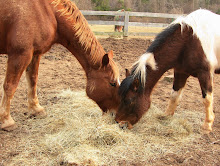Charlie from HorseTrainingResources.com here....
In Today's Horse Tips Magazine Issue:
"Can You
Move Your Horse With Your Pinky?"
---
Note: Many of you
have seen this tip before but I keep
getting comments about it. Since
there are quite a few new readers, at
the risk of repeating, I am sending it
again.
---
Here's a great
quote I have adapted:
"Books and
DVDs do not make a rider good or bad,
but they can
make him better or worse."
Some horse owners
get it, some don't.
Some like to get
in the game with
their horse and do
the things horsemen do.
Others just feed
their horses every
day and ride 'em
once a week if that.
Whatever.
But if you're one
of those that like to mess with your
horse, then here's a cool little trick
to try.
When you lead your
horse and stop him,
try squaring him
up.
Basically,
squaring him up means his
two front feet are
directly across from each other and his
two back feet are directly across from
each other.
He's almost
statue-like...standing at
attention like a
Marine soldier fresh
out of boot camp.
Squaring up a
horse isn't as easy as
it may sound.
You keep moving
them around until you
get a foot where
you want it.
But once you do,
then they move another foot. Then, they're still not squared up.
One thing to
remember when doing this
is that the horse
doesn't know what you want.
You'll keep moving
him and he'll likely willingly move -
but it won't be purty at first.
Like any training,
after a while he'll
get good at it
because you've done it enough and he'll
know what you want.
Here's the cool
trick I was telling you about. It makes it easier to get him moving the correct foot.
As you're holding
the lead rope just
below where it
clips to the halter, point your pinky at
the foot you want him to move.
Picture this.
You're standing on
the right side of the horse up by his
head.
Your left hand is
holding the lead rope just below the
halter.
You point to his
left front foot because you need him to
move it back a little to be square.
The way you point
while holding the lead rope puts a
certain kind of pressure on the halter
and helps him learn what to do.
Thus, when you
point to the other front foot, the
pressure is applied differently on his
face from the halter.
When he learns
that the pressure to that particular
spot on his face is applied, that cues
him to move that foot.
Will he know how
to do this right off the bat?
You could be so
lucky.
He's gotta learn
it.
But this is a
great way to stay consistent and ask him
to move.
If you ask him to
square up and you ask in a different way
all the time, he'll never know what you
want.
It's only fair you
ask him the same way all the time.
This is how
professional trainer Diana Quintana
describes doing it in her DVD. If
you want to read about her, click the
following:
Diana Quintana DVD
Diana is an
excellent trainer. This DVD is titled:
"“Want To
Train Your Horse?”
It's a great DVD
and ull of great info.
Now...what's good about
squaring up a horse?
First, when you
get him to move it's
like putting
another quarter in your piggy bank of
respect for you from him.
In other words,
anytime you get a horse to move it
builds respect for you in his mind.
Also, anytime you can
get a horse to move their feet they are
concentrating on you and not off in
la-la land.
Two, you are
messing with him a lot.
You'll be walking
around...checking him.
You may lean over
to look at his back feet.
You may squat a
little to check his front feet.
And so on.
This gets him used
to movement going on around him.
What's good about
that?
He'll eventually
relax as you walk around him. You definitely want that.
The more movement
you do around him the better.
But the other good
thing is this.
Your vet and
farrier will appreciate it because they
have to move around the horse a lot.
Ultimately, it
translates into a higher degree of
safety for you, your vet, your farrier,
and anyone else who walks around the horse.
And as far as I'm
concerned...safety is what it's all
about.
Diana Quintana DVD
Oh - and don't
forget - a little positive
attention and
praise goes a long way.
Check out the DVD
titles we have - you can learn a lot
watching these
professional trainers and how they handle
different
situations. Note how they encourage
their
horses to get the
right response.
That's it for today.
Please stay safe out there.
Charlie
Loretta
the natural horseman
clear communication/visible results






